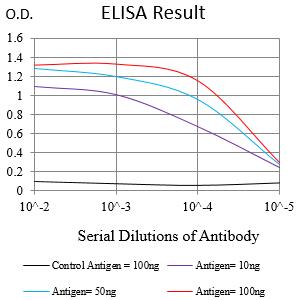
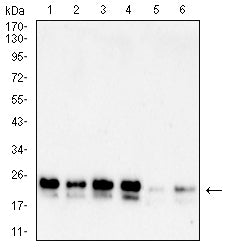
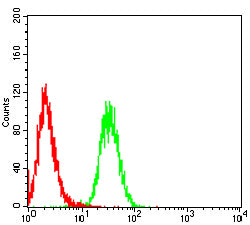
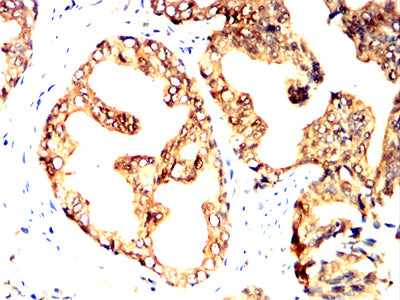
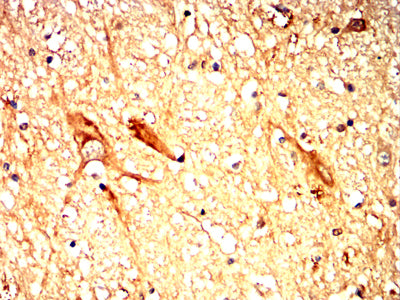
| WB | 1/500 - 1/2000 | Human,Mouse,Rat |
| IF | 咨询技术 | Human,Mouse,Rat |
| IHC | 1/200 - 1/1000 | Human,Mouse,Rat |
| ICC | 技术咨询 | Human,Mouse,Rat |
| FCM | 1/200 - 1/400 | Human,Mouse,Rat |
| Elisa | 1/10000 | Human,Mouse,Rat |
| Aliases | DJ1; DJ-1; GATD2; HEL-S-67p |
| Entrez GeneID | 11315 |
| clone | 2B1G12 |
| WB Predicted band size | 19.8kDa |
| Host/Isotype | Mouse IgG1 |
| Antibody Type | Primary antibody |
| Storage | Store at 4°C short term. Aliquot and store at -20°C long term. Avoid freeze/thaw cycles. |
| Species Reactivity | Human |
| Immunogen | Purified recombinant fragment of human PARK7 (AA: 1-189) expressed in E. Coli. |
| Formulation | Purified antibody in PBS with 0.05% sodium azide |
+ +
以下是关于PARK7(DJ-1)抗体的3篇参考文献的简要概括(文献信息为示例性整理,具体内容需参考真实文献):
1. **文献名称**:*Development and validation of a novel PARK7/DJ-1 monoclonal antibody for neurodegenerative disease research*
**作者**:Smith A, et al.
**摘要**:本研究报道了一种高特异性PARK7单克隆抗体的开发,验证了其在人脑组织和帕金森病模型中的检测效果,证实其可用于Western blot和免疫组化分析。
2. **文献名称**:*DJ-1 antibody-based detection of oxidative stress markers in Alzheimer's and Parkinson's disease models*
**作者**:Chen L, et al.
**摘要**:利用PARK7抗体探究DJ-1蛋白在神经退行性疾病中的氧化应激保护作用,发现其在阿尔茨海默病和帕金森病模型中表达水平异常,与疾病进程相关。
3. **文献名称**:*PARK7 interacts with α-synuclein in vivo: Evidence from co-immunoprecipitation assays using specific antibodies*
**作者**:Yamamoto K, et al.
**摘要**:通过PARK7抗体进行免疫共沉淀实验,揭示了DJ-1与α-突触核蛋白的相互作用,提示其在帕金森病病理蛋白聚集调控中的潜在功能。
4. **文献名称**:*Evaluation of serum DJ-1 as a biomarker using a novel ELISA system with dual antibody recognition*
**作者**:Zhang R, et al.
**摘要**:开发了一种基于双PARK7抗体的ELISA检测方法,评估了血清DJ-1作为帕金森病早期诊断生物标志物的敏感性和特异性。
注:以上文献标题和内容为示例性总结,实际文献需通过PubMed等平台检索确认。
PARK7. also known as DJ-1. is a multifunctional protein encoded by the *PARK7* gene, initially linked to early-onset Parkinson’s disease (PD). It plays roles in antioxidative stress, mitochondrial regulation, and cellular homeostasis. Mutations in *PARK7* are associated with autosomal recessive PD, driving research into its pathological mechanisms. PARK7 antibodies are essential tools for studying this protein’s expression, localization, and function in both healthy and diseased states.
These antibodies enable detection of PARK7 in various applications, including Western blotting, immunohistochemistry, and immunofluorescence. Researchers use them to investigate PARK7’s interaction with pathways implicated in neurodegeneration, such as oxidative damage mitigation and α-synuclein aggregation. PARK7 antibodies also help explore its potential roles beyond PD, including cancer, metabolic disorders, and inflammation.
Commercially available PARK7 antibodies are typically raised against specific epitopes, with validation in human or model organism tissues. Challenges include ensuring specificity due to structural similarities with other proteins. Recent studies highlight PARK7’s dual role as a biomarker and therapeutic target, emphasizing the need for reliable antibodies to advance diagnostic and therapeutic strategies for PD and related conditions.
×